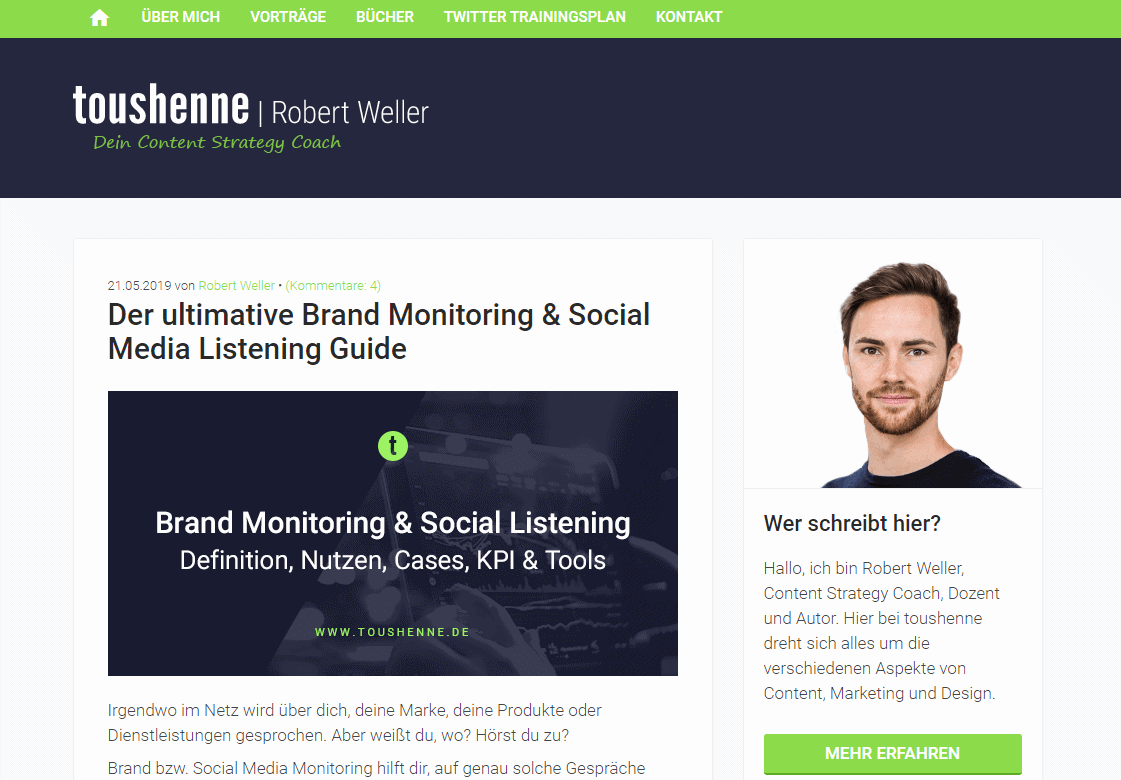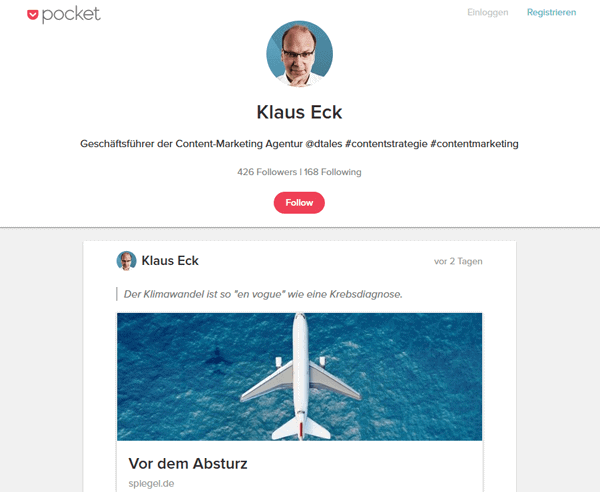Content curation is one of the best ways for freelancers and agencies to generate attention and reach online. For example, with the aim of demonstrating expertise. When implemented strategically, it is an excellent way to build your own brand. But what is important? And how can content curation be implemented in practice?
Content Curation: Cultivate your content!
The term "content curation" consists of two parts. Content means content, curating in this context means preparing and distributing. Specifically, "curation" is derived from the Latin word "curator" - it means caretaker or representative. You may be familiar with curators in relation to museums, where they are responsible for archiving exhibits. In the artistic field, they are responsible for compiling and exhibiting the material. So you could say that curators are responsible for the care, organization and dissemination of objects.
If you connect this description with the word content, then content curation means nothing more than the compilation of content and its distribution. My very esteemed colleague Falk Hedemann defines the discipline in his article on content curation as follows:
Content from different sources is compiled, put into context and sorted.
How does content curation work?
Maybe you've carried out some academic work in the past. In this process, you'll have read sources on your topic or theory which you'll have then cited as evidence for or against your topic/thesis. This is exactly what content curation is. You take some content, a statement or a position from someone else and quote it to support or argue against your statement or thesis.
Broken down into small steps, the process looks like this: You...
- Scan sources
- Select sources
- Process them
- Publish them
This could be a tweet, post, or comment from someone else. You can record any statement made my another to process it in a blog article. It must be clear that this is somebody else's content, however. You can't just copy someone else's work. Copyright law is interpreted very strictly by some sources, such as publishers, so you must ask when in doubt.
I work with content curation fairly often. Specifically, for example, in the article On the myth of 1,000 words. In it, I addressed my colleague Vladislav Melnik's statement that a blog article MUST have at least 1,000 words. I disagreed and still disagree. In the post, I argued this accordingly to make my position clear. The article subsequently generated a lot of discussion on his blog and on mine. That, in turn, brought us a lot of traffic and attention on the web - which is exactly how content curation works.
Tip: It's important to always choose a reputable source to work with. This is the only way to establish yourself as an expert. If you choose a non-reputable source, you're telling the online community you don't know how to distinguish a good source from a bad one. The community members are unlikely to forgive such an error in judgment.
Become an expert with external articles
It was considered taboo for many years to share the content of others, especially the content of your competitors. After all, people only wanted their own content to get noticed. Sure, this thinking is understandable. But it's too short sighted.
Academia shows us how it's done properly. A researcher can only show they're familiar with a topic once they've considered statements, results, and opinions of other scientists and had their own thesis verified or falsified on this basis. This person:
- Is able to assess the industry
- Knows what the current (scientific) status is in this area
- Can give meaningful reasons for his/her own opinion
It's these points that help build and consolidate one's own status as an expert.
My colleague Robert Weller shows what this looks like in practice. He writes about content strategy on his blog toushenne. He has recently published an article entitled "The ultimate brand monitoring and social media listening guide". In it, he works with an extremely large number of external sources to formulate his list and explanation:

Robert links to all of these sources and clearly labels them. By doing this, he shows he's well versed in the topic. He knows exactly which sources and authors he has to name to give structure and content to his article. At the same time, he compares these sources and evaluates them in his comments in order to draw conclusions.
This not only strengthens his expert status as a content strategist, but also his personal brand. He also draws the attention of the people mentioned to himself through the links. In the best case scenario, they thank him publicly for the mention, reply to him or share his post on their channels. In this way, Robert gains access to communities that he would otherwise not have reached or would have found difficult to reach.
Tip: If you mention people in your articles, tweets, Facebook posts etc., tag/mark them. This has several advantages: People become aware of you. In the best case scenario, they will inform their community that you have mentioned them.
You can expand your reach this way and more people will take notice of you. The people you mention may follow you on your channels and you'll have more chance to expand your network.
Formats for content curation
Sharing content on your social media and posting blog articles are two popular ways to curate content. But there are more ways out there:
E-Paper
Tools like Paper.li or Nuzzel offer the service of curating different articles into a kind of newspaper or article compilation. Bundling good professional articles for the target group can be a very good way for the reputation.
Infographics
Infographics are quick and easy to create visually. With tools such as Infogram or Pictochart, you can create good infographics quickly and easily in the respective basic version. They are a real eye-catcher because not everyone always offers such graphics.
Only if you are working with external facts in the case of content curation: If these are not common knowledge, or if they are provided by someone else, ask the authors in advance if you can make an infographic out of them. Ideally, they will then also share it with their contacts.
Expert interviews
Interviews with experts have many advantages. They're perfectly suited to:
- Provide exclusive content
- Show you know who is important in the industry
- Demonstrate how you can lead a discussion
On the one hand, you can ask exclusive questions in this way and thus gain unique insights. On the other hand, contact with experts complements and strengthens your network. Christa Goede has published an interview with content marketing expert Carsten Rossi from the Kamann Rossi agency that is well worth reading. Her example shows how well such interviews can work.
Case studies
Presenting and discussing an authentic case study from practice is a very good way to engage in content curation. Discussing a case, presenting the advantages and disadvantages of actions and evaluating results show how much you know about the subject matter. A case study can also be supplemented with sources from other experts, so that a detailed and qualitative discussion can be created. This can further enhance your own reputation. You can find examples of case studies in content marketing at textbroker.de, for example.
E-books
E-books are also great for content curation. If you already have several blog articles on a particular topic then publishing them together in an e-book is simple. You just need to create the introduction and transitions and add articles from other experts. The result is a collection of well-founded sources including your own texts, which are published as a "book" in your name.
As an example, take a look at the performance e-book from Raidboxes\. In a kind of internal content curation, the collected knowledge of the team was used - including references to suitable external sources:
Books are simply still THE WAY to be perceived as an expert. Admittedly: A printed book published by a publishing house will pay even more in terms of reputation in many areas. But an e-book is an excellent start.
What is important in curating?
Good content curation involves being clear about who your target groups are and what information they need. So think in advance about the topics you want to curate content on. In my case, for example, it concerns the topics of social media and blogging.
Think about a system with which you can view and archive sources. I use Pocket and Evernote for this. I use Pocket to save articles that I want to read later and don't want to lose. Pocket itself also offers the option of following other users and their content, as the example of content expert Klaus Eck shows:

I make notes on certain content and save the source information in Evernote.
As already mentioned: Make sure your sources are reputable - read the content carefully. You have the impression that the source is not quite "clean"? Or you can't understand the content? Then leave it alone. If the latter is the case, you can of course deal with it critically. The question is, however, whether you might trigger a shitstorm and get caught in the crossfire yourself.
Save time and use planning tools to share content. For example, you can use Buffer or Hootsuite (free in the basic version). With them, you can schedule your content in advance and publish it automatically.
"*" indicates required fields
I recommend you always add an accompanying and introductory text when you curate content. This shows that you have actually read the content, can classify it and which aspects/points you agree or disagree with. By the way, this is also one of the central tasks of serious journalism: the classification of events. If you curate content without commentary, then your target groups/fans/followers cannot classify the content.
However, I have to confess one thing: I sometimes share tweets on Twitter from sources I trust unconditionally, for example because the headline speaks for itself. And because I know that my community can classify the content. Then I sometimes rely on feedback from my contacts. You learn something new every day and "look out for each other".
Conclusion
Content curation can be a great way to expand your reach and build your reputation as an expert - if you put in the effort. At the same time, working with external sources and statements expands your knowledge and broadens your horizons.
Especially the discussion with other points of view and approaches offers you the opportunity to create your own content that builds on this or considers a counter thesis. Content that represents a counter-opinion and deals critically with a statement is read and shared with pleasure. Even if your personal goal is to strengthen your brand, the relevance of the content for your readers should always be in the foreground.
Contributed image: Andrew Neel @Unsplash
